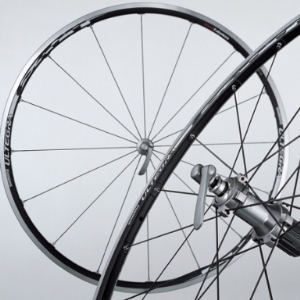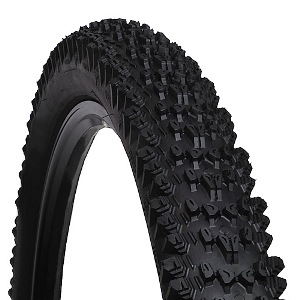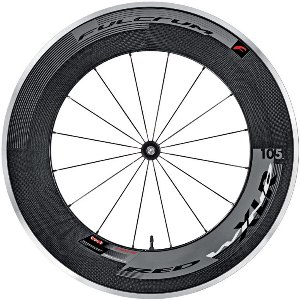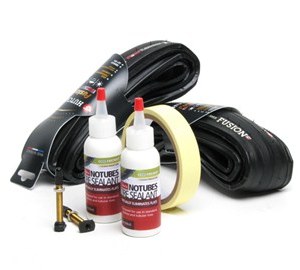All About Tubeless

It has come to our attention that, amid ever-updated technology, some newer triathletes may be well served by a primer on the basics of wheel and tire types. For the well-seasoned athlete, a refresher course never hurts – and you just might learn something new.
Specifically, with the advent of tubeless tires, the number of options and standards (and confusion) continues to rise; we aim to strain the muck from these waters for you. To start, we must establish that there are three main types:
1. Tubular (also called sew-up) – this is a self-contained tire and inner tube system that gets affixed to the wheel rim with adhesive glue or tape. Air is pumped in to a valve stem, which is attached to the inner tube.
2. Clincher – features a separate inner tube and tire that gets affixed to the wheel rim via a mechanical interface between the tire beads and edges of the rim (bead hooks). Air is pumped in to a valve stem, which is attached to the inner tube.
3. Tubeless clincher – same mechanical interface as a standard clincher, but due to a special rim and tire construction, there is no inner tube. The valve stem is affixed to the rim, and air gets pumped directly in to the tire.
To simplify the application of these three types, tubular is primarily seen as a “racing” application – the rim’s lack of bead hooks makes the system lighter. Clincher is primarily seen as a “normal” tire – and almost always used for training due to the simplicity of use. Tubeless clinchers are a relatively new beast when it comes to bicycles (however it is very common on, say, automobiles). While first used for mountain bikes, in recent years some road-specific applications have become available. The key advantage and reason that tubeless has become so popular in the mountain bike scene is threefold: 1) Removal of the tube makes the system potentially lighter and faster rolling (depending on several factors), 2) It allows lower tire pressures and makes pinch-flatting a thing of the past, and 3) When coupled with a liquid sealant, it makes the possibility of punctures much less common. Tubeless is not all gravy, however. There are many ways to skin this cat – with various rim and tire standards, conversion kits, and even do-it-yourself “ghetto tubeless” options.

In the Beginning…
Tubeless officially debuted for mountain bikes in 1999. Mavic, Michelin, and Hutchinson worked together to create a new standard for mountain wheels and tires called Universal System Tubeless, or UST. Under this new standard, the tire’s casing is thicker all the way around – essentially transferring the weight and material of an inner tube on to the tire itself. The tire beads must feature a very specific shape and diameter, which perfectly fit a rim of specific shape and diameter. The rim must also feature a smooth bed with no spoke holes. The inflation valve attaches to the rim via a rubber gasket on one side, and a tightening nut on the other. When made to the proper specifications, the UST tire and rim combination work beautifully – they hold consistent air pressure and do not require the use of liquid tire sealant. If you want to add sealant for extra protection, you’re even better off.
Only two short years after UST was established, a second group of products emerged, spearheaded by Stan’s NoTubes. While UST works well, it is not lighter or faster rolling than a standard mountain bike tire and tube, because the tire itself is stiffer and weighs more. People wanted a way to use a standard tire without a tube. In theory, it would be more flexible, faster rolling, and clearly lighter weight. Stan’s began selling a special proprietary rim that accommodated this market void, as well as conversion rim strips to adapt a “normal” rim to tubeless.
In a short order of time, Stan’s products became highly coveted by professional athletes, and have since been ridden to several Olympic medals and World Championship wins. There are, however, a few compromises that come with this type of system. First, installation is not as simple as UST or inner tubes. Often times an air compressor is required to “blast” the tire beads in to place, due to the lack of stiff UST sidewalls and beads. Second, you must use a latex-based tire sealant. These sealants dry in to place and help the tire bead seal (necessary because the non-UST tire bead is not designed for this type of use). Last, you must maintain these types of systems throughout the year. The sealants dry out (by design), and must be topped off every few months. As well, the conversion kits – while an economical option to convert your old wheel set to tubeless – are known for being a science experiment of sorts. Be prepared to spend an afternoon figuring out exactly how many layers of tape or foam you need for a proper rim-to-tire fit… and you’re never guaranteed ultimate success. But you ARE likely guaranteed a mess in your garage.
More recently, a third group of products have emerged. They’re not UST, and they’re not Stan’s. These products hold manufacturer-specific names and standards, such as Bontrager’s TLR, Specialized 2Bliss, and Geax TNT. These tires typically feature a UST-like bead, but a non-UST casing to save weight and improve rolling resistance. They do not hold air without sealant, but are theoretically easier to install than a true tube-intended tire (however they may still require a compressor). Most of these tires work on any type of rim: “standard”, UST, or Stan’s.

It ought to be mentioned that – with any tubeless system – tire changes are a little more challenging than a traditional tubed clincher. While most road-based triathletes don’t change tires based on conditions, the Xterrans among you may change tires all the time. If you ride Kenda tires, for example, you may use their smooth tread Small Block Eight for dry days. For mixed conditions you may pick the intermediate tread Karma… and a muddy day might warrant their aggressive Nevegal. If you use inner tubes, tire changes are a snap. With tubeless, however, you have to deal with sealant, and the sometimes-finicky procedure of getting the tire beads seated. It’s not impossible, but for the time-crunched athlete squeezing in that ride after work, every minute counts. If you use tubeless, you’re generally stuck with a single tire choice. Most folks choose an intermediate-type tread; and then suffer the increased rolling resistance on dry surfaces or lack of grip on loose or muddy surfaces.
Tubeless on the Road
The benefits of tubeless tires are clear for mountain bike applications. Might some of these benefits transfer to road? Hutchinson and Shimano thought so, and in 2006, introduced Road Tubeless to the world. While a compelling idea, market reception has been decidedly lukewarm in comparison to fat tires. The naysayers say this:
It doesn’t weigh less than my normal clincher tire and inner tube.
There aren’t many wheels and tires to choose from.
The Coefficient of Rolling Resistance (Crr) isn’t lower.
So far, we can only reply with: true, true, and true. What, then, are the benefits? It really comes down to one biggie – barring a huge cut in your tire, it’s almost impossible to get a flat tire. You must use a liquid latex sealant with these tires, which do a wonderful job of quickly sealing most types of punctures. With only one layer of material to seal (the tire), sealants are more effective than when used in an inner tube or tubular tire (which have two layers that must be sealed – tire and tube). If you do happen to get a big gash in your tubeless tire, they readily accept an inner tube to get you home.
For this technology to really shine, we need more players in the game. As of now, most tubeless-specific wheels are shallow-section aluminum: Shimano Dura Ace and Ultegra, Fulcrum 2-Way Fit wheels, and a few others. Corima prototyped and sold a tubeless version of their mid-depth carbon “Aero+” wheel, but it appears that this product has since been discontinued. The latest aluminum/carbon aero wheels from Fulcrum are tubeless compatible, and stand as the only deep-section choice. For tires, you’ve got a few models from Hutchinson, Maxxis, and IRC.

One option you do have now is to convert your existing wheel set using a conversion kit from Stan’s or Effetto Mariposa. These kits typically include some sort of sealing tape to cover the spoke holes, special valves (or a rubber rim strip with valve), and a sealant injector. For truly deep section wheels, you must use a valve extender which replaces the valve core at the very end (offered by Stan’s NoTubes and Zipp, for example). Finish the deal with a pair of road tubeless tires, and you’re off and rolling.
These conversions can work – and work well. Similar to the mountain bike conversions, however, you are still at the mercy of the tire and wheel gods. Will you need an air compressor to achieve inflation? Maybe. Will the fit between the tire and rim be sufficiently tight? If the trade winds blow the right way… but you may also be left struggling with different amounts of sealing tape to get the job done (again, with the mess in your garage). As of today, I personally would be nervous to travel with a converted wheel set to a race. What if your tires lose their seal while in-flight? That could mean a sealant mess in your bike case, and a frantic drive to find an air compressor. A tubeless-ready aero wheel would likely solve these potential problems – they just don’t exist, outside of Fulcrum’s few choices.
As well, I am of the opinion that there must be an agreed-upon standard for wheel and tire manufacturers to adhere to. Mountain bikes have the UST standard, but there is no “Road UST”. For mountain, you can buy a tire from any manufacturer and pair it with a wheel of any manufacturer; as long as they are both certified-UST, they will work together. In road, Hutchinson was the first to make sell tubeless, but they didn’t patent it. While it leaves the door open for other manufacturers, it also means that nobody else knows exactly how they make it – smart move on their part. Wheels can become certified as “Road Tubeless” by Hutchinson if the manufacturer sends rim cross sections and CAD drawings for approval… but that does not assume that the wheel is approved for Maxxis or IRC tubeless tires. Will the manufacturers cooperate and play nice? Time will tell, but I certainly hope so.
The Verdict
Does road tubeless make sense for you? My verdict is 2-part. For training, a qualified yes. If you own a pair of tubeless ready wheels, live in an area with debris-laden roads, and don’t mind a little extra work on the front-end, tubeless makes a lot of sense. It could very well save you a lot of future headaches and tube changes. For racing purposes, I say: Great idea with tons of potential, but we’re not quite there yet. If we can get enough legitimate aero wheel options that are tubeless-specific, along with tire technology that is among the faster-rolling choices, I think we will have a huge winner. Think of it: all the speed of the current latex-inner-tubed tires, plus aerodynamic wheel performance, PLUS near flat-proof. That’s just what your next long-course race is asking for.
And what of the Xterra athletes among you? For the more serious athletes, perhaps a true racer’s tubeless setup is worth the effort. You really can’t get much lighter than a Stan’s ZTR wheel set with a light racing (non-tubeless specific) tire. But, for those who are just dabbling or do one Xterra per year, there is absolutely nothing wrong with using inner tubes. Put a few ounces of sealant in them for good measure, and go have fun. Yes, you must use slightly higher tire pressure to avoid pinch flats, but it’s not the end of the world. Or, for the easiest tubeless option, look no further than UST. You don’t save any weight, but nearly all of these tire and rim combinations will inflate with a floor pump, and you can use low pressure and avoid punctures. Much of this discussion is also dependent on geography or climate. If you live an Arizona, you’re probably interested in avoiding as many cactus-thorn flats as possible (whether you’re on road or mountain). Tubeless is probably your best choice. Live in an area with clean roads and smooth trails, however, and it’s a toss up.
Whatever you decide, keep your ears open and your eyes peeled on this promising technology.



